
The Dragon 32 and Dragon 64 are home computers that were built in the 1980s. The Dragons are very similar to the TRS-80 Color Computer, and were produced for the European market by Dragon Data, Ltd., initially in Swansea, Wales before moving to Port Talbot, Wales and by Eurohard S.A. in Casar de Cáceres, Spain, and for the US market by Tano Corporation of New Orleans, Louisiana. The model numbers reflect the primary difference between the two machines, which have 32 and 64 kilobytes of RAM, respectively.

720° is a skateboarding video game released in arcades by Atari Games in 1986. The player controls a skateboarder skating around a middle-class neighborhood. By doing jumps and tricks, the player can eventually acquire enough points to compete at a skate park. The game's name comes from the "ultimate" trick, turning a full 720° in the air after jumping off a ramp.

Tempest is a 1981 arcade video game by Atari, Inc., designed and programmed by Dave Theurer. It takes place on a three-dimensional surface divided into lanes, sometimes as a closed tube, and viewed from one end. The player controls a claw-shaped "blaster" that sits on the edge of the surface, snapping from segment to segment as a rotary knob is turned, and can fire blaster shots to destroy enemies and obstacles by pressing a button.
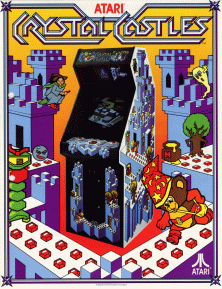
Crystal Castles is an arcade video game released by Atari, Inc. in 1983. The player controls Bentley Bear who has to collect gems located throughout trimetric-projected rendered castles while avoiding enemies, some of whom are after the gems as well.

Super Pitfall is a 1986 side-scrolling non-linear platform game for the Nintendo Entertainment System (NES). Despite the title screen stating that it was reprogrammed by Pony Inc, the development of the NES version was handled by Micronics, a Japanese developer who mostly ported arcade games to the NES.

H.E.R.O. is a video game designed by John Van Ryzin and published by Activision for the Atari 2600 in March 1984. The game has players control Roderick Hero who traverses a mineshaft avoiding enemies and hazards to rescue trapped miners. He travels through the mines equipped with a hoverpack that allows him to traverse the game levels as well as bombs and laser that let him destroy walls and defeat enemies respectively.

Dragon Spirit is a 1987 vertical-scrolling shooter arcade game developed and published by Namco. In North America, it was distributed by Atari Games. Controlling the dragon Amur, the player must complete each of the game's nine areas to rescue the princess Alicia from the demon Zawell. Similar to Namco's own Xevious, Amur has a projectile weapon for destroying air-based enemies and a bomb for destroying ground enemies. It ran on the Namco System 1 arcade board.
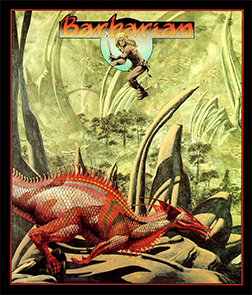
Barbarian is a 1987 platform game by Psygnosis. It was first developed for the Atari ST, and was ported to the Amiga, Commodore 64, MS-DOS, MSX, Amstrad CPC, and ZX Spectrum. The Amiga port was released in 1987; the others were released in 1988. The cover artwork is by fantasy artist Roger Dean.

Microdeal was a British software company which operated during the 1980s and early 1990s from its base at Truro Road in the town of St Austell, Cornwall. The company, founded by John Symes was one of the major producers of games and other software for the 8-bit home computers of the time, in particular the Dragon 32 and the similar Tandy TRS-80 Color Computer ("CoCo").
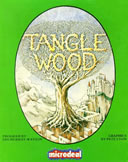
Tanglewood is a puzzle/adventure computer game published by Microdeal for the Dragon 32 and TRS-80 Color Computer in early 1987. It was released for the Atari ST and Amiga in 1988.
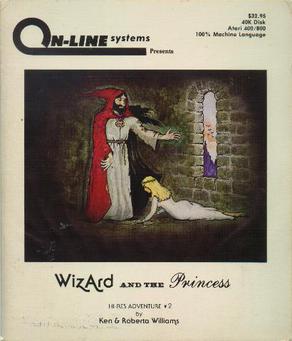
Wizard and the Princess is a graphic adventure game written for the Apple II and published in 1980 by On-Line Systems. It is the second installment in the Hi-Res Adventures series after Mystery House. Unlike its predecessor, which featured monochrome drawings, Wizard and the Princess introduced color graphics. Ports for the Atari 8-bit computers and Commodore 64 were released in 1982 and 1984 respectively. The 1982 self-booting disk version for IBM PC compatibles was renamed Adventure in Serenia.

Circus is a block breaker arcade video game released by Exidy in 1977, and distributed by Taito in Japan. The game is a re-themed variant of Atari, Inc.'s Breakout, where the player controls a seesaw and clown in order to pop all the balloons in the level. The game has been copied and released under different names by numerous other companies in both the United States and Japan.
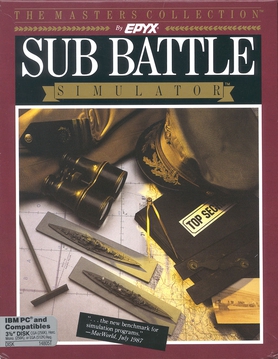
Sub Battle Simulator is a naval combat simulation game released by Epyx in 1987. The game was developed by Digital Illusions, Inc. It was released for the Amiga, Apple IIGS, Commodore 64, Atari ST, Macintosh, MS-DOS, and the Tandy Color Computer 3.

Karateka is a 1984 martial arts action game for the Apple II by Jordan Mechner. It is his first published game and was created while he was attending Yale University. The game was published in North America by Broderbund and in Europe by Ariolasoft. Along with Karate Champ and Yie-Ar Kung Fu, Karateka is one of the earliest martial arts fighting games. It was inspired by Japanese culture and by early Disney animated films and silent pictures. An influential game of its era, it was one of the first to use cinematic storytelling and sound design, and rotoscoped animation.
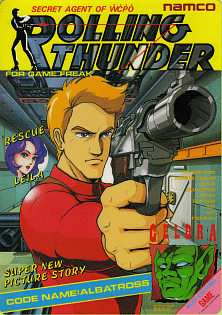
Rolling Thunder is a run and gun video game developed by Namco in Japan and Europe and released in 1986 as a coin-operated arcade video game using the Namco System 86 hardware. It was distributed in North America by Atari Games. The player takes control of a secret agent who must rescue his female partner from a terrorist organization. Rolling Thunder was a commercial success in arcades, and it was released for various home computer platforms in 1987 and the Nintendo Entertainment System in 1989. The original arcade game has been included in various classic game compilations as well. It influenced later arcade action franchises such as Shinobi and Time Crisis, which borrowed mechanics such as taking cover behind crates.
Peter Michael Lyon is a UK-based visual artist who has worked in a wide range of 2D and 3D media spanning from traditional oil painting to computer graphics, for the science fiction and fantasy genres. According to his personal website, he has been involved in various works in the computer games industry such as graphic production, teaching and management, with 3D modelling and animation. He is known as a pioneer graphic designer for the Atari and the Amiga in the 1980s and 1990s.
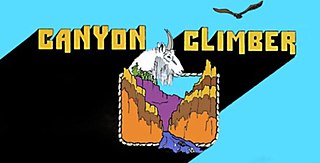
Canyon Climber is a video game designed by Steve Bjork and James Garon for the TRS-80 Color Computer and published by Tandy Corporation in 1982. Ports to other home computers were published by Datasoft. Canyon Climber is a three-screen platform game with an American Southwest theme. Two of the screens are direct analogs of those in Donkey Kong.

Plutos is a vertically scrolling shooter developed by Tynesoft and published by Micro Value in 1987. The game was released for the Amiga and Atari ST, and was a heavily inspired by the 1984 arcade game Star Force. In 1991, the game was re-issued on Prism Leisure's "16-Bit Pocket Power" imprint.

Clowns and Balloons is a circus-themed video game written by Frank Cohen for Atari 8-bit computers and published in 1982 by Datasoft. The game was also released for the TRS-80 Color Computer, written by Steve Bjork who had released a similar game called Space Ball for the TRS-80 in 1980. Clowns and Balloons is a clone of the 1977 arcade game Circus. A variant of Breakout, the player moves a trampoline left and right to catch a bouncing clown who pops rows of balloons at the top of the screen with his head.

Danger Ranger is a non-scrolling platform game designed by Ken Kalish and published in 1983 by Microdeal for the Dragon 32/64 and TRS-80 Color Computer. The game was ported to the Atari 8-bit computers and Commodore 64 by Rita Jay in 1984.


















